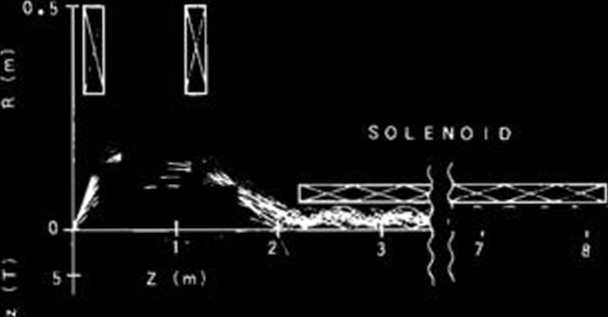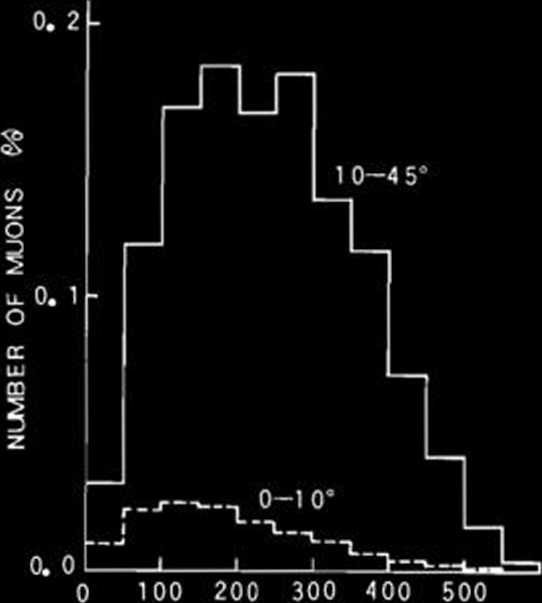372596138
94
RIKEN Accel. Próg. Rep. 24 (1990)
111-5-2. Design of a Decay Muon Channel Using an Axially Symmetric
Magnetic Field for a Pion Injector
K. Ishida, T. Matsuzaki, and K. Nagamine
A beam transportation system with an axially symmetric magnetic field may be used for achieving one order larger solid angle than con-ventional systems using magnetic dipoles and quadrupoles. We have designed a powerful decay muon channel which uses superconducting coils producing this type of symmetric field as a pion injector and a superconducting solenoid as a decay section. One example of the design calcula-tion is shown in Fig. 1. The pion momentum was injection”). The latter case was intended to simu-late a smali divergence injection with conven-tional systems. Figurę 2 shows the calculated muon intensity at the exit of the solenoid decay section as a function of the muon emission angle for both cases. We can conclude that the large solid angle system can be used for generating nearly one order morę muons than conventional ones. Morę detailed design work aiming at reduc-ing stray field on a pion production target and reducing neutron background is now in progress.
INJECTOR

03
Fig. 1. An example of the design calculation of a high acceptance pion injecetor for decay muon channel. The field distribution is shown on the lower side. Trajec-tories of pions (emission angle 10-45 degrees) surviving as muons are shown on the upper side.

MUON EMISSION ANGLE <mr)
Fig. 2. Angular distribution of muons at the exit of the solenoid decay section. Vertical axis shows the number of muons divided by the pion intensity at the source. The solid linę is the case for the muons originating from pions with an emission angle in the rangę of 10-45 degree. The broken linę is for those from pions in the rangę of 0-10 degree.
set to be 150 MeV/c. The pion source distribution (square of 2 cmX2 cm), the pion emission angle (10-45 degree), and the time and the angle of decay were Monte-Carlo generated. The number of transmitted muons originating from pions with a large emission angle in the rangę of 10-45 degrees (“large solid angle injection”) was compared with that from pions with a smali emission angle of 0-10 degree (“smali angle
Wyszukiwarka
Podobne podstrony:
102 RIKEN Accel Próg. Rep. 24 (1990)111-5-8. Performance of Isotopic Separation in RIPS T.Nakamura,
92 RIKEN Accel. Próg. Rep. 24 (1990)111-5. Instrumentation1. Design of a Microbeamline for a Compact
103 RIKEN Accel. Próg. Rep. 24 (1990)111-5-9. Test Experiment of the GARIS/IGISOL K. Morita, T. Nomu
105 RIKEN Accel. Próg. Rep. 24 (1990)111-5-10. Velocity Distribution of IGISOL lon Beams M. Koizumi,
108 RIKEN Accel. Próg. Rep. 24 (1990)111-5-12. Status Report of the RIKEN Swinger-Magnetic Analyzer
110 RIKEN Accel. Próg. Rep. 24 (1990)111-5-14. Test for Dispersive-Mode Beam Transportto the SMART
116 RIKEN Accel. Próg. Rep. 24 (1990)111-5-19. Responses of Large Position-Sensitive Detectorsto Hea
RIKEN Accel. Próg. Rep. 24 (1990)111-5-25. High Speed Serial Data Link for PC-9801 J. Fujita > PC
11 RIKEN Accel. Próg. Rep. 24 (1990)111-1-2. Three a Disintegration of 12C in the Field of208Pb Nucl
12 RIKEN Accel. Próg. Rep. 24 (1990)111-1-3. Coulomb Breakup Reaction of 90 MeV/u 140 T. Takei, T. M
29 RIKEN Accel. Próg. Rep. 24 (1990)111-1-19. Dissociation Cross Sections of nLiK. Soutome, S. Yamaj
RIKEN Accel. Próg. Rep. 24 (1990)111-1-20. Induced Fission Studied with a Multi-DimensionalLangevin
48 RIKEN Accel. Próg. Rep. 24 (1990)111-2-15. High Resolution L X-Ray Angular Distribution Measureme
56 RIKEN Accel. Próg. Rep. 24 (1990)111-2-22. Electron Spectra from Doubly Excited Boroń lonsProduce
63 RIKEN Accel. Próg. Rep. 24 (1990)111-2-28. Development of Nuclear Track Microfilters N. Nakanishi
72 RIKEN Accel. Próg. Rep. 24 (1990)111*3-8. Dry Separation of Radioactive Nuclides from a Gold Targ
74 RIKEN Accel. Próg. Rep. 24 (1990)111*3-10. A Multitracer Study of the Adsorption of Metal Element
więcej podobnych podstron